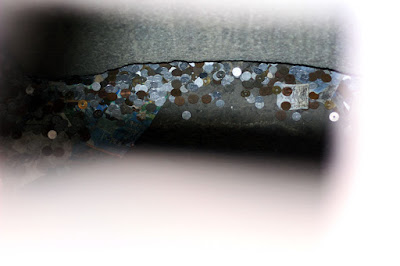When you visit Kyoto, make sure that you won’t miss Fushimi
Inari Shrine (伏見稲荷大社), especially if you love Japanese manga and anime so much. Having the catchy orange color, this shrine could always
attract photographers and tourists to come here again and again due to the sunlight that comes across toriis (鳥居 shrine
gates). Beautiful!!!
Fushimi Inari Shrine could be reached by getting off at Inari
Station. Take a a bit walk and soon you’ll find a lot of souvenir and snack
shops before you reach Fushimi Inari Shrine. Our advice: don’t find your snacks and souvenirs first
because you are about to have a hard work up there. Hahahaha..... After leaving
those irresistible deals behind, you’ll find a lot of people in Main Shrine.
You could wash your hand, make a prayer as Japanese or write a prayer on an
orange torii-looking Ema (board to write your wishes).
If you are ready enough, let’s find the line of torii and let the party begins!
Fushimi Inari Shrine was built at the western of Inari Mountain and presented for
Inari Okami (God of Harvest). Why are
there so
much toriis here? Inari Okami is known as guardian of abundant crops, business,
prosperity and family safety. Businessmen make toriis as their form of gratitudes and prayers.
 |
| prize of torii (credit : inari.jp) |
Since we reaced Inari Station, portraits of fox always appeared, like in Inari Station, in front of Main
Shrine, among the path of toriis, Inner Shrine, everywhere. Citizens believe
that spirit fox, known as Inari Okami’s servant, could send our hopes to Inari
Okami.
The beginning of the journey was so crowded. People gave all
efforts to walk along that path. We were so surprised to find that there was a
Japanese woman wearing kimono and geta (wooden sandals)
going up and down the stairs. How could she? Foody, who was wearing sport shoes and normal clothes
(T-shirt and jeans) was so afraid to fall down, then how could she do that?
If you have climbed high enough, you’ll find Kyoto city view
from Inari Mountain. It was about 12.30PM when we got there. No heat, just
fresh air and beautiful scenery.
But no wonder, due to its height, a lot of
tourists began to go down, back to Main Shrine. We still could find small
restaurants in this height and people could enjoy
their lunch here.
We decided to face Inner Shrine first before having our lunchs.
After a long walk and high stairs, we reached the Inner Shrine. Not as big as
Main Shrine but still there was a lot of people prayed here, especially
Japanese people. Throwing coins to the box, claping hands twice, make a prayer
and claping hands once again. In the back of the inner shrine, you could find written
torii Emas placed around.
Japanese, Korean, Chinese, English and
others.
 Finished our target, then
way
to go down. It’s even more dangerous to go down than go up. We spent much time
here and only could
find vending machines. No more
restaurants in this height. Slowly and carefully, we arrived in Main Shrine and
finally eat our lunch, Kyoto sushi that we bought on street before we got here.
Finished our target, then
way
to go down. It’s even more dangerous to go down than go up. We spent much time
here and only could
find vending machines. No more
restaurants in this height. Slowly and carefully, we arrived in Main Shrine and
finally eat our lunch, Kyoto sushi that we bought on street before we got here.
After that, time for snacking and shopping. We enjoy our 700
yen grilled quail (uzura うずら) and 500 yen big size
yakitori.
uzura
grilled yakitori
After searching in many souvenir stores, we bought a pretty yet
elegant geisha doll.
Good journey, good foods. Yeahhhh!!!!!
This shrine opens 24 hours. However, it is better to get here
at morning or afternoon. Because when it’s getting dark, it seems to be more
dangerous to go up and down the stairs. But some people say that it’s quite
pretty at night due to light from lamp that reflects the orange toriis.
Address
=
68 Fukakusa Yabunouchicho, Fushimi Ward,
Kyoto City 612-0882
Website
= http://inari.jp
We eat, we walk, we talk
-FoodyFooty2-
contact and follow us on:
email : foodyfooty2@gmail.com
facebook : foody footy
twitter : @foodyfooty2
instagram : @foodyfooty2































